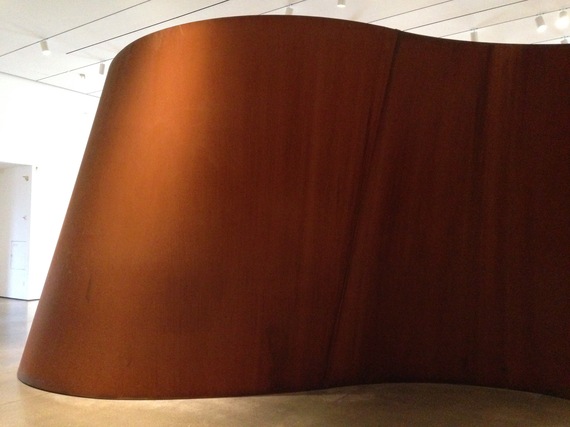What's a brand? A singular idea or concept that you own inside the mind of the prospect." - Al Ries, chairman and co-founder, Ries & Ries Focusing Consultants

Serra's art has become an instantly recognizable brand. When you see massive rusting steel plates in a museum or plaza, the word "Serra" flashes in your mind. A Serra is about massive weight, materiality and scale that controls your experience. Being in or around one--or watching one being installed--is meant to inspire awe and at least a tinge of sublime fear. Every Serra installation is both a work of art and a marketing device that reminds us of the artist's market dominance.
Honestly, Jones seems to be the one having the tantrum--an art critic tantrum--but in comparing Serra to McDonalds he does touch on an interesting point: its not entirely off base to compare a leading contemporary artist to a ubiquitous brand. One artist friend of mine uses a similar metaphor to poke fun at a broader phenomenon. He notes that contemporary art museums across the U.S. tend to showcase the same "menu" of blue chip contemporary artists, so he calls these museums "Olive Gardens." Theodor Adorno once cautioned that the "commoditization of culture results in conformity," and the seeping presence of "branding" into the field of contemporary art feels consistent with his warning.
Serra's Sequence, I would argue, is a kind of logo in steel that "sells" the related "products" on view at SFMOMA, which is now the largest institution of its kind in the world. As any good marketing student knows, effective branding can result in the sales of not just one product, but of other products associated with that brand. The broader field of Contemporary Art ™, with its values of progress, boundary pushing and cultural significance draws more and more well-educated, well-funded individuals towards its commoditized magnetism.
Just a block away from SFMOMA, mega-dealer Larry Gagosian has just opened his 16th location. Has there ever been a more powerful art brand than Gagosian Gallery? Gagosian has played a crucial role in advancing Serra's career and the presence of Sequence at SFMOMA must be one of the most validating and powerful "product placements" ever. Gagosian Gallery, it should be mentioned, is listed as one of SFMOMA's Corporate Donors, right after Ferrari of San Francisco. Contemporary Art, like Ferrari, is a luxury brand.
In San Francisco, where the 2015 median home value is $1,135,900, luxury brands are the ones that do well.
